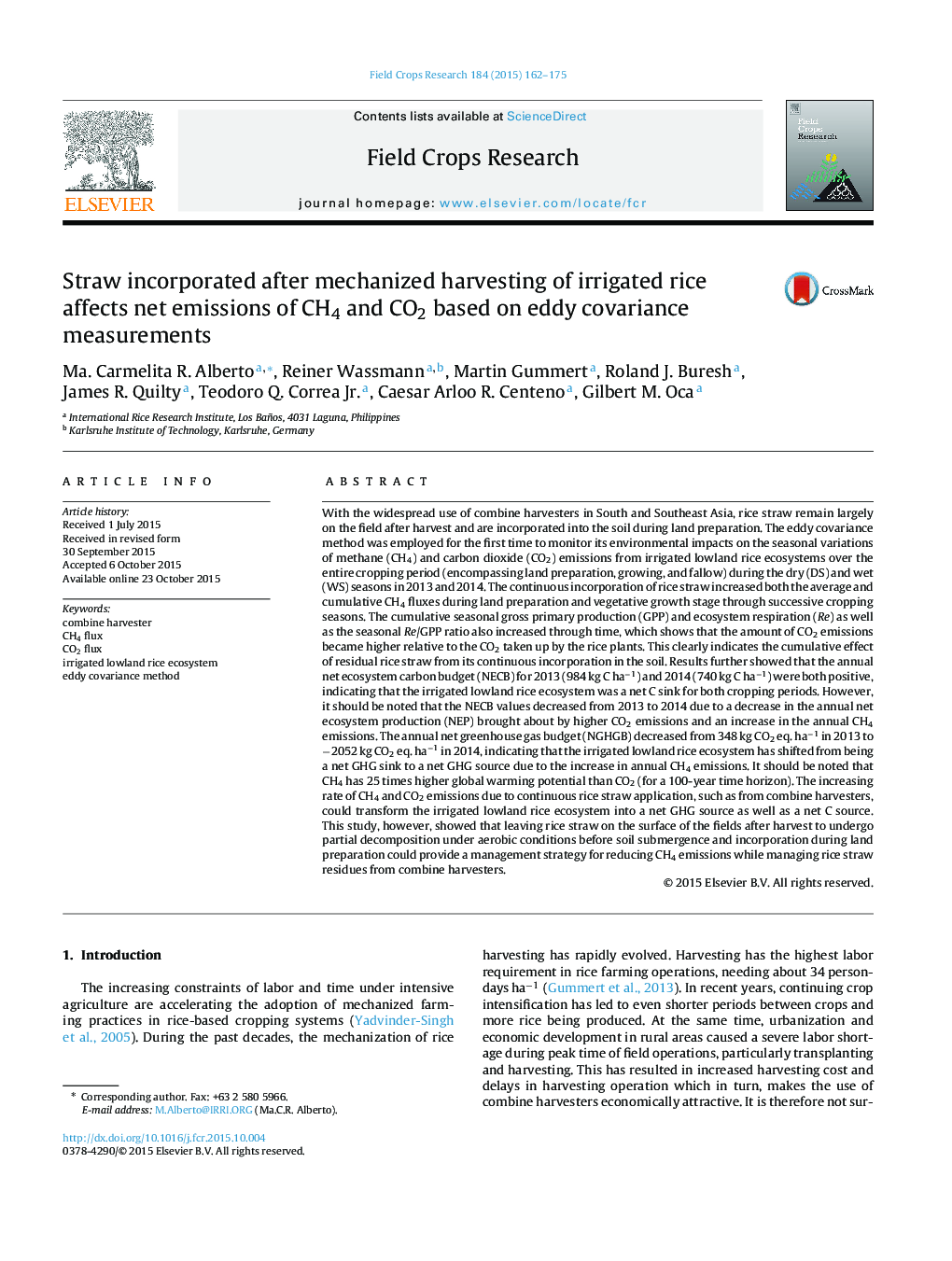| کد مقاله | کد نشریه | سال انتشار | مقاله انگلیسی | نسخه تمام متن |
|---|---|---|---|---|
| 6374656 | 1624679 | 2015 | 14 صفحه PDF | دانلود رایگان |
عنوان انگلیسی مقاله ISI
Straw incorporated after mechanized harvesting of irrigated rice affects net emissions of CH4 and CO2 based on eddy covariance measurements
دانلود مقاله + سفارش ترجمه
دانلود مقاله ISI انگلیسی
رایگان برای ایرانیان
کلمات کلیدی
موضوعات مرتبط
علوم زیستی و بیوفناوری
علوم کشاورزی و بیولوژیک
علوم زراعت و اصلاح نباتات
پیش نمایش صفحه اول مقاله

چکیده انگلیسی
With the widespread use of combine harvesters in South and Southeast Asia, rice straw remain largely on the field after harvest and are incorporated into the soil during land preparation. The eddy covariance method was employed for the first time to monitor its environmental impacts on the seasonal variations of methane (CH4) and carbon dioxide (CO2) emissions from irrigated lowland rice ecosystems over the entire cropping period (encompassing land preparation, growing, and fallow) during the dry (DS) and wet (WS) seasons in 2013 and 2014. The continuous incorporation of rice straw increased both the average and cumulative CH4 fluxes during land preparation and vegetative growth stage through successive cropping seasons. The cumulative seasonal gross primary production (GPP) and ecosystem respiration (Re) as well as the seasonal Re/GPP ratio also increased through time, which shows that the amount of CO2 emissions became higher relative to the CO2 taken up by the rice plants. This clearly indicates the cumulative effect of residual rice straw from its continuous incorporation in the soil. Results further showed that the annual net ecosystem carbon budget (NECB) for 2013 (984 kg C haâ1) and 2014 (740 kg C haâ1) were both positive, indicating that the irrigated lowland rice ecosystem was a net C sink for both cropping periods. However, it should be noted that the NECB values decreased from 2013 to 2014 due to a decrease in the annual net ecosystem production (NEP) brought about by higher CO2 emissions and an increase in the annual CH4 emissions. The annual net greenhouse gas budget (NGHGB) decreased from 348 kg CO2 eq. haâ1 in 2013 to â2052 kg CO2 eq. haâ1 in 2014, indicating that the irrigated lowland rice ecosystem has shifted from being a net GHG sink to a net GHG source due to the increase in annual CH4 emissions. It should be noted that CH4 has 25 times higher global warming potential than CO2 (for a 100-year time horizon). The increasing rate of CH4 and CO2 emissions due to continuous rice straw application, such as from combine harvesters, could transform the irrigated lowland rice ecosystem into a net GHG source as well as a net C source. This study, however, showed that leaving rice straw on the surface of the fields after harvest to undergo partial decomposition under aerobic conditions before soil submergence and incorporation during land preparation could provide a management strategy for reducing CH4 emissions while managing rice straw residues from combine harvesters.
ناشر
Database: Elsevier - ScienceDirect (ساینس دایرکت)
Journal: Field Crops Research - Volume 184, December 2015, Pages 162-175
Journal: Field Crops Research - Volume 184, December 2015, Pages 162-175
نویسندگان
Ma. Carmelita R. Alberto, Reiner Wassmann, Martin Gummert, Roland J. Buresh, James R. Quilty, Teodoro Q. Jr., Caesar Arloo R. Centeno, Gilbert M. Oca,